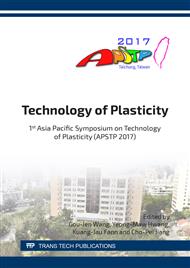[1]
P. Homola, M. Kadlec, R. Růžek, J. Šedek, Fatigue behaviour of tailored blank thermoplastic composites with internal ply-drops, Procedia Struct. Integrity 5 (2017) 1342-1348.
DOI: 10.1016/j.prostr.2017.07.144
Google Scholar
[2]
M. Merklein, M. Johannes, M. Lechner, A. Kuppert, A review on tailored blanks—Production, applications and evaluation, J. Mater. Process. Technol. 214 (2014) 151-164.
DOI: 10.1016/j.jmatprotec.2013.08.015
Google Scholar
[3]
H. W. Zhang, Y. P. Guan, J. L. Wu, X. H. Liu, Transverse Bending Characteristics in U-channel Forming of Tailor Rolled Blank, J. Iron. Steel Res. Int. 23 (2016) 1249-1254.
DOI: 10.1016/s1006-706x(16)30184-4
Google Scholar
[4]
G. Sun, H. Zhang, G. Lu, J. Guo, J. Cui, Q. Li, An experimental and numerical study on quasi-static and dynamic crashing behaviors for tailor rolled blank (TRB) structures, Mater. Des. 118 (2017) 175-197.
DOI: 10.1016/j.matdes.2016.12.073
Google Scholar
[5]
R. Kopp, C. Wiedner, A. Meyer, Flexibly rolled sheet metal and its use in sheet metal forming, Adv. Mater. Res. 6-8 (2005) 81-92.
Google Scholar
[6]
X. H. Liu, Prospects for variable gauge rolling: technology, theory and application, J. Iron. Steel Res. Int. 18 (2011) 1-7.
Google Scholar
[7]
D. C. Wang, L. C. Dong, H. M. Liu, Y. Wang, Velocity Preset and Transitional Zone's Shape Optimization for Tailor Rolled Blank, J. Iron. Steel Res. Int. 22 (2015) 279-287.
DOI: 10.1016/s1006-706x(15)30001-7
Google Scholar
[8]
H. W. Zhang, X. H. Liu, L. Z. Liu, P. Hu, J. L. Wu, Forming Limit and Thickness Transition Zone Movement for Tailor Rolled Blank during Drawing Process, J. Iron. Steel Res. Int. 23 (2016) 185-189.
DOI: 10.1016/s1006-706x(16)30032-2
Google Scholar
[9]
G. Hirt, C. Abratis, J. Ames, A. Meyer, Manufacturing of sheet metal parts from tailor rolled blanks, J. Technol. Plast. 30 (2005) 1-12.
Google Scholar
[10]
L. Duan, G. Sun, J. Cui, T. Chen, A. Cheng, G. Li, Crashworthiness design of vehicle structure with tailor rolled blank, Struct. Multidiscip. Optim. 53 (2016) 321-338.
DOI: 10.1007/s00158-015-1315-z
Google Scholar
[11]
E. Shafiei, K. Dehghani, Tensile behavior of tailor rolled blanks with longitudinal thickness transition zone: Introducing a new tensile specimen, Vac. 143 (2017) 71-86.
DOI: 10.1016/j.vacuum.2017.06.001
Google Scholar
[12]
A. A. Zadpoor, G. Campoli, J. Sinke, R. Benedictus, Fracture in bending – The straining limits of monolithic sheets and machined tailor-made blanks, Mater. Des. 32 (2011) 1229-1241.
DOI: 10.1016/j.matdes.2010.10.005
Google Scholar
[13]
Y. Morishita, T. Kado, S. Abe, Y. Sakamoto, F. Yoshida, Role of counterpunch for square-cup drawing of tailored blank composed of thick/thin sheets, J. Mater. Process. Technol. 212 (2012) 2102-2108.
DOI: 10.1016/j.jmatprotec.2012.05.011
Google Scholar


